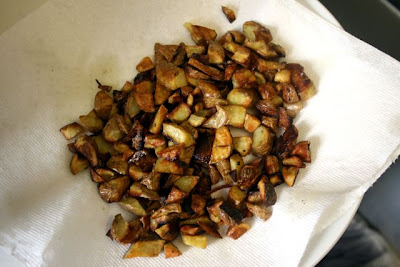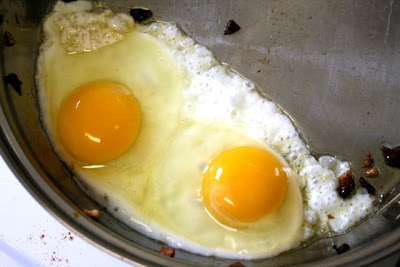Oy Vey: Gefilte Fish
9 Apr
“Don’t learn to make gefilte fish,” Grandma Ruth told me when she heard of my plans. “It’s not worth it. Learn to make something that you’ll eat more than once a year.” Grandma’ always right, and this was no exception, as it turned out. But still, I had to do it! For the project!
You know, I never really liked gefilte fish. At this moment, though, I truly hate it. This week I finally hit my first true, flat-out, nothing doing, face down failure of the project. Sure, there have been some things that didn’t come out perfect so far, but nothing that took up hours of time and more money than I’d like to admit only to leave me with nothing usable. Other than some fish stock, which I guess counts for something.
Let’s start at the start. I took the day off for Passover, as my parents were hosting the seder at their place on Thursday and it seemed like as good a time as any to take a crack at How to Cook Everything‘s recipe for Gefilte Fish, definitely an all day affair. Now, for the uninitiated out there, gefilte fish is a processed fish that you eat at passover seders. It tastes pretty much exactly how it looks, mild and benign and a little weird, but sort of familiar and nice at the same time. It was never my favorite thing in the world, but once a year I eat half a piece and call it a day. It never actually occurred to me until I saw it in HTCE that you might think of making it from scratch.
The main ingredient here is 3 lbs. of whitefish fillets (carp or pike will do as well) and 3 lbs. of scraps (head, skeletons, etc.). You put the scraps in a pot with celery, bay leaf, peppercorns, and an onion and essentially make a stock from it. Then you take the fillets, throw ’em in the food processor with another onion, chop it up together pretty fine, add some eggs and matzoh meal, and form egg shaped balls out of this mixture. You put those in the pot with the stock and scraps and about 3 cups of carrots, and let these balls cook for about an hour and a half. Gross, right? But I bet it tastes pretty good all in all, despite the fact that 90 minutes seems like a terribly long time to cook fish. Who am I to argue with tradition, though.
So, around 10 in the morning I went the Whole Foods Theme Park, a.k.a. Whole Foods Bowery (seriously that place is unreal). The fish guy there was incredibly helpful in helping me pick out a couple whitefish, which he then filleted, skinned, and left me with the scraps in addition to the fillets. Boondoggle number one occurred when I left with just the fillets but no scraps. OK, so, cab ride back to the Bowery and then another cab home with scraps in hand (I was in a bit of a time crunch). So those go into the pot, and I turn my attention to making the fish/onion mixture. Oh, what’s this! It’s hundreds of pin bones still in the fillets. Trying to get them out was frustrating, I don’t think I had the right tools and I’m not really very experienced with these things.
Alright, I’ve already been in three cabs today, what’s the hurt in two more? So, back out to Whole Foods (this time the Union Square one).
“Do you have whitefish fillets? Boneless? I really need them without bones.”
“Yes.”
“Okay, great, I’ll take three pounds. Can you take the skin off?”
“Sure.”
“Awesome. And you’re sure there’s no bones?”
“Yes.”
“Great. I’ll take it.”
I don’t want to tell you how much I paid for those three pounds of boneless skinless filets, but suffice it to say it was in keeping with the usual Whole Foods range. So imagine my surprise when I got home to find even more pin bones than in the first batch of fillets! And for what it’s worth, he also left on a fair amount of the skin. Way to half ass it, Whole Foods Union Square! It wasn’t even crowded; I was the only customer at the fish counter at the time.
That’s it. End of story. Pretty anticlimactic, I know. I do have a few quarts of delicious fish stock to show for my troubles, and I did think it was kind of fun preparing that fish head for the pot. I’ll have to work with whole fish more often. That’s a plus, one more thing I’m feeling confident about in the kitchen. Thanks for nothing, Whole Foods. You’re gonna have a really angry guy returning a lot of fish fillets tomorrow morning, FYI.
Next year, in Jerusalem! Or at least in NYC, with homemade gefilte fish. You gotta be reasonable, know what I mean?


























